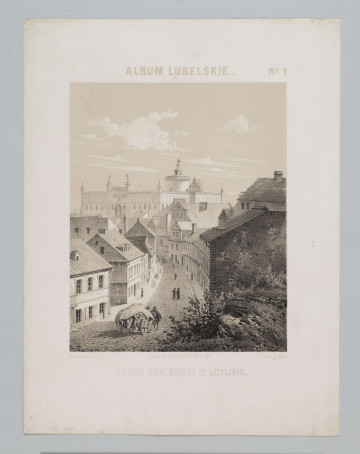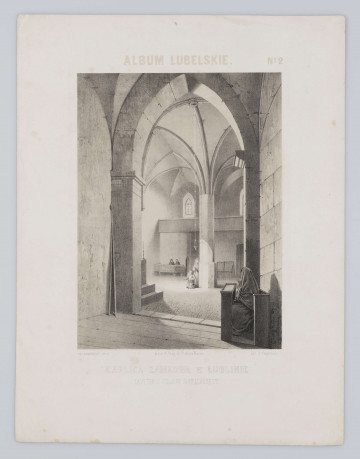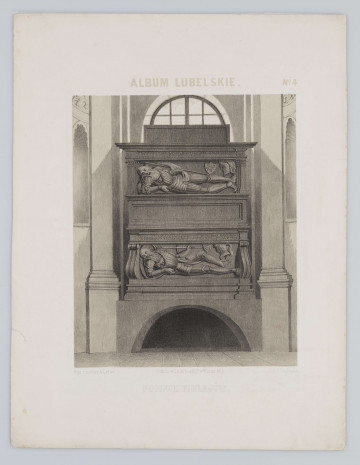
Royal Castle in Lublin
1857
National Museum in Lublin
Part of the collection: Lubliniana. Painting views of Lublin and the Lublin Region
Krakowskie Przedmieście, the main street of Lublin, was constructed in a part of the Krakow suburbs. Its development is related to the transfer of the markets to the square in front of the Kraków Gate at the beginning of the 17th century. Previously, it was called Wielka or Krakowska Street (although the road to Krakow never led this way), but the current name has been used since the end of the 18th century. From the first quarter of the 19th century, the street was being expanded up to today’s Litewski Square eventually becoming the commercial and administrative centre of the city. In the nineteenth century, there were offices, elegant hotels, restaurants, cafes and shops. Its current architecture combines buildings from different eras. Some of them date back to the beginning of the 17th century and were extended and rebuilt in the 18th and 19th centuries. Most of them were built from the beginning of the 19th century up until the 1950s. The oldest building is the Church of the Holy Spirit (1419-1421). Many of the tenement houses have an interesting history. The tenement house No. 6 from 1836 belonged to the German merchant Jan Mincel, the owner of a ‘spice and haberdashery’ shop, that was immortalised in the novel Lalka (The Doll) by Bolesław Prus. The Chmielewski family, owners of tenement house No. 8, founded an elegant confectionery shop at the beginning of the 20th century that was visited by such notables as Hanka Ordonówna. One of the owners of the tenement house at number 25 was Stanisław Magierski, a pharmacist and soldier of the Home Army, author of the famous partisan song Dziś do ciebie przyjść nie mogę….(Today I cannot come to you ...). In the tenement house No. 27 there was a sophisticated confectionery and the Semadeni cafe, established in 1875. The splendor of the city was highlighted by the 19th-century hotels located here: Saski (No. 23), Angielski (No. 21), Rzymski (No. 32), Poznański (No. 34), Bawarski, known as Zajazd pod Białym Koniem (No. 39), and above all the Europa Hotel (No. 29), modelled on the Warsaw Hotel Europejski (No. 29), as well as the Victoria Hotel located in the vicinity of the Capuchins, from the balcony of which, in November 1918, Ignacy Daszyński announced the establishment of the Provisional People’s Government of the Republic of Poland.
The view shows a fragment of the street. On the right are tenement houses of various heights, behind which the hill and the cathedral towers emerge. On the left, on the corner of Krakowskie Przedmieście and Poczętkowska streets (now Staszica), is the Magierski and Wilczyński tenement house with a landmark awning above the store. In the distant perspective, the Trinitarian Tower is visible.
Renata Bartnik
Author / creator
Dimensions
cały obiekt: height: 32,1 cm, width: 26,2 cm
Object type
graphics
Technique
lithography
Material
paper
Creation time / dating
Creation / finding place
Owner
The National Museum in Lublin
Identification number
Location / status

1857
National Museum in Lublin

1857
National Museum in Lublin

1857
National Museum in Lublin
DISCOVER this TOPIC
Museum of King Jan III's Palace at Wilanów
DISCOVER this PATH
Educational path